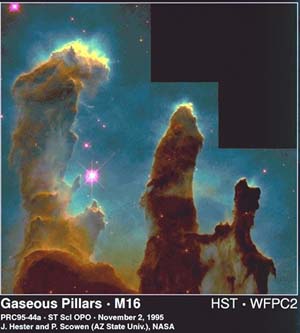
|
Table of Contents for the
|
 |
|
Special cameras are used to take pictures of stars like this one. |
|
|
Stars are a fascinating component of our universe. They may seem like permanent objects in the sky, but technology has allowed us to photograph the heavens, and now we know more about stars than ever before. They are born, they live, and then they die. How does this happen? That’s what this activity is all about! A star’s life is long compared to that of a human, but we can see the stages of stellar birth, aging, and death in the heavens. They follow a pattern similar to many of the life cycles we see here on earth. Stars are born, they “grow up,” exist many years, and then they die, and there’s an exciting battle between the force of gravity and gas pressure to that makes it exciting and potentially explosive! Comparison Diagram of Human lifetime and Star lifetime - Stars and Humans share a similar phases in their lives Space: What’s out there? Space
may seem empty, but actually it is filled with thinly spread gas and
dust. This gas and dust is called interstellar
medium. The atoms of gas are mostly hydrogen (H2),
and the gas atoms are typically about a centimeter apart. The dust
is mostly microscopic grains and comprises only a few percent of the
matter between stars. The dust is mostly carbon and silicon. In some
places, this interstellar medium is collected into a big cloud of
dust and gas known as a nebula. This
is the birthplace of stars because the gas and dust is what makes
up a star. In fact, our sun was probably born in a nebula nearly 5
billion years ago. Space
may seem empty, but actually it is filled with thinly spread gas and
dust. This gas and dust is called interstellar
medium. The atoms of gas are mostly hydrogen (H2),
and the gas atoms are typically about a centimeter apart. The dust
is mostly microscopic grains and comprises only a few percent of the
matter between stars. The dust is mostly carbon and silicon. In some
places, this interstellar medium is collected into a big cloud of
dust and gas known as a nebula. This
is the birthplace of stars because the gas and dust is what makes
up a star. In fact, our sun was probably born in a nebula nearly 5
billion years ago.
|
|

